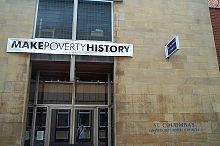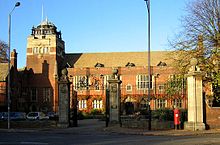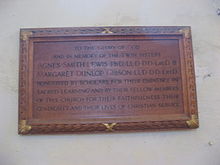- Agnes and Margaret Smith
-
Agnes Smith Lewis PhD LLD DD LittD (1843–1926) and Margaret Dunlop Gibson LLD DD LittD (1843–1920), nées Agnes and Margaret Smith (sometimes referred to as the Westminster Sisters), were Semitic scholars. Born twin daughters[1][2] of John Smith of Irvine, Ayrshire, Scotland, they learnt more than 12 languages between them, and became pioneers in their academic work and benefactors to the Presbyterian Church of England, especially to Westminster College, Cambridge.
Contents
Early life and training
The twins were brought up by their father John (their mother having died 3 weeks after their birth), a solicitor and amateur linguist[3]. They were trained in private schools in Birkenhead and London[4], interspersed with travels in Europe guided by John[5].
After John's death, they settled in London and joined the Presbyterian church in Clapham Road[6]. Already conversationally fluent in German, French and Italian[7], they continued to learn languages and travelled in Europe and the Middle East, travelling up the Nile in 1868[8]. In 1870, Agnes wrote Eastern Pilgrims, an account of their experiences in Egypt and Palestine[9].
In 1883, Agnes and Margaret, now quite fluent in Greek, travelled to Athens and other parts of Greece[10], beginning a lifelong affectionate relationship with Greek Orthodoxy, whose monks occupied St. Catherine's Monastery at Sinai. In this year, Margaret married[11] James Gibson; and in 1887, Agnes married[12] Samuel Savage Lewis, librarian of Corpus Christi College, Cambridge[1]. Both were clergymen. Sadly, each marriage was soon ended with the death of the husband[13].
Academic work
By 1890, the sisters settled in Cambridge. Agnes began to study Syriac (Margaret took it up later, in 1893[14]), and improve their Arabic, which Agnes had begun to learn in 1883[15]. Enthused by Quaker Orientalist James Rendel Harris's account of his discovery at Saint Catherine's Monastery of a Syriac text of the Apology of Aristides, and by news of Constantin von Tischendorf's rediscovery there of Codex Sinaiticus[16], they travelled to the monastery in 1892, and discovered the earliest Syriac version of the Gospels known thus far. The next year, they returned as part of a larger party[17] that included Professor Robert Bensly and Francis Crawford Burkitt, as well as J. Rendel Harris, to transcribe the whole of the manuscript, known as the Sinaitic Palimpsest or the Sinaitic Manuscript (Lewis), which provided fresh stimulus to New Testament studies. The palimpsest was found to have previously contained a Syriac Lives of the Saints by John the Recluse[18]. During the expedition, Agnes and Margaret also catalogued the monastery's extensive collection of Syriac and Arabic manuscripts[19]. Janet Soskice's account of the expedition describes it as 'disjoint', and recounts it as subject to increasing mutual suspicion and resentment[20].
The sisters continued to travel and write until the First World War, and were instrumental in other discoveries, including that by Solomon Schechter of an early Hebrew manuscript of Ecclesiasticus[21].
Harris's Cambridge course in palaeography allowed Agnes to step onto the academic stage as a Syriac scholar 'of international repute'[22] as author of the introduction to the expedition team's 1894 publication of a translation of the palimpsest. Though the University of Cambridge never honoured them with degrees (it did not admit women to degrees until 1948), they received honorary degrees from the universities of Halle, Heidelberg[23], Dublin, and St Andrews[24], including the first theological doctorates awarded to women.
At Cambridge, they attended St Columba's Church[25]. They were generous hostesses at their home, Castlebrae, which became the centre of a lively intellectual and religious circle.
Benefaction
 St Columba's United Reformed Church, established as the Presbyterian chaplaincy to the University of Oxford, with the help of the Smith sisters.
St Columba's United Reformed Church, established as the Presbyterian chaplaincy to the University of Oxford, with the help of the Smith sisters.
The sisters used their inheritance to endow Westminster College in Cambridge[26]. This was long after Nonconformists were allowed to become full members of the Oxbridge universities by the repeal of the Test and Corporation Acts; and that Presbyterian college moved from Queen Square, London to a site acquired from St John's College, Cambridge in 1899. They also helped the establishment of the Presbyterian chaplaincy to the University of Oxford, now at St Columba's United Reformed Church.
Works
of Agnes Smith
- Eastern Pilgrims: The travels of three ladies (London, 1870)
- Effie Maxwell (London, 1876) (a novel)
- The Brides of Ardmore: A story of Irish life (London, 1880)
- Through Cyprus (London, 1887)
- Glimpses of Greek Life and Scenery (1884) (London: Hurst and Blackett)
of Agnes Smith Lewis
- Catalogue of the Syriac MSS. in the Convent of S. Catharine on Mount Sinai (London, 1894)
- A Translation of the Four Gospels from the Syriac of the Sinaitic Palimpsest (London and New York, 1894)
- A Translation of the Four Gospels from the Syriac of the Sinaitic Palimpsest (London, 1896) (revised and extended edition)
- Some Pages of the Four Gospels Re-transcribed from the Sinaitic Palimpsest with a Translation of the Whole Text (London, 1896)
- A Palestinian Syriac Lectionary (London, 1897)
- In the Shadow of Sinai: A story of travel and research from 1895 to 1897 (Cambridge, 1898)
- Select Narratives of Holy Women: From the Syro-Antiochene or Sinai Palimpsest (London, 1900)
- Apocrypha Syriaca: The Protevangelium Jacobi and Transitus Mariae (London, 1902) (Texts; English translation)
- Acta Mythologica Apostolorum (London, 1904) (Texts; English translation)
- The Old Syriac Gospels or Evangelion da-Mepharreshê (London, 1910)
- Light on the Four Gospels from the Sinai Palimpsest (London, 1913)
of Margaret Dunlop Gibson
- How the Codex Was Found: A narrative of two visits to Sinai from Mrs. Lewis's journals, 1892 - 1893 (Cambridge, 1893)
- An Arabic Version of the Epistles of St. Paul to the Romans, Corinthians, Galatians with part of the Epistle to the Ephesians from a ninth century MS. in the Convent of Saint Catharine on Mount Sinai. Studia Sinaitica (1894). London: C J Clay and Sons
- Catalogue of the Arabic mss. in the Convent of Saint Catharine on Mount Sinai. Studia Sinaitica (1894). London: C J Clay and Sons
of Agnes Smith Lewis and Margaret Dunlop Gibson
- The Palestinian Syriac Lectionary of the Gospels (London, 1899)
Further reading
- Soskice, Janet (2009-09-06). The Sisters of Sinai: How Two Lady Adventurers Discovered the Hidden Gospels. Alfred A. Knopf. ISBN 978-1-4000-4133-6. http://www.nytimes.com/2009/09/06/books/review/Alexander-t.html?scp=1&sq=Janet%20Soskice&st=cse. Retrieved 2010-04-23.
- Whigham Price, Alan (1985) The Ladies of Castlebrae. London: Headline Book Publishing.
Gallery
References
- ^ "LEWIS, Mrs. Agnes Smith". Who's Who, 59: p. 1053. 1907. http://books.google.com/books?id=yEcuAAAAYAAJ&pg=PA1053.
- ^ "GIBSON, Margaret Dunlop". Who's Who, 59: p. 674. 1907. http://books.google.com/books?id=yEcuAAAAYAAJ&pg=PA674.
- ^ Soskice, Janet (2010) Sisters of Sinai: How Two Lady Adventurers Found the Hidden Gospels. London: Vintage, 10
- ^ Soskice, Janet (2010) Sisters of Sinai: How Two Lady Adventurers Found the Hidden Gospels. London: Vintage, 21
- ^ Soskice, Janet (2010) Sisters of Sinai: How Two Lady Adventurers Found the Hidden Gospels. London: Vintage, 25
- ^ Soskice, Janet (2010) Sisters of Sinai: How Two Lady Adventurers Found the Hidden Gospels. London: Vintage, 56
- ^ Soskice, Janet (2010) Sisters of Sinai: How Two Lady Adventurers Found the Hidden Gospels. London: Vintage, 29
- ^ Soskice, Janet (2010) Sisters of Sinai: How Two Lady Adventurers Found the Hidden Gospels. London: Vintage, 33- 51
- ^ Soskice, Janet (2010) Sisters of Sinai: How Two Lady Adventurers Found the Hidden Gospels. London: Vintage, 56
- ^ Soskice, Janet (2010) Sisters of Sinai: How Two Lady Adventurers Found the Hidden Gospels. London: Vintage, 67
- ^ Soskice, Janet (2010) Sisters of Sinai: How Two Lady Adventurers Found the Hidden Gospels. London: Vintage, 71
- ^ Soskice, Janet (2010) Sisters of Sinai: How Two Lady Adventurers Found the Hidden Gospels. London: Vintage, 91
- ^ Soskice, Janet (2010) Sisters of Sinai: How Two Lady Adventurers Found the Hidden Gospels. London: Vintage, 84 (Gibson), 107 (Lewis)
- ^ Soskice, Janet (2010) Sisters of Sinai: How Two Lady Adventurers Found the Hidden Gospels. London: Vintage, 207
- ^ Soskice, Janet (2010) Sisters of Sinai: How Two Lady Adventurers Found the Hidden Gospels. London: Vintage, 71
- ^ Soskice, Janet (2010) Sisters of Sinai: How Two Lady Adventurers Found the Hidden Gospels. London: Vintage, 111
- ^ Soskice, Janet (2010) Sisters of Sinai: How Two Lady Adventurers Found the Hidden Gospels. London: Vintage, 146 - 187
- ^ Soskice, Janet (2010) Sisters of Sinai: How Two Lady Adventurers Found the Hidden Gospels. London: Vintage, 135, 173
- ^ Soskice, Janet (2010) Sisters of Sinai: How Two Lady Adventurers Found the Hidden Gospels. London: Vintage, 168
- ^ Soskice, Janet (2010) Sisters of Sinai: How Two Lady Adventurers Found the Hidden Gospels. London: Vintage, 171
- ^ Soskice, Janet (2010) Sisters of Sinai: How Two Lady Adventurers Found the Hidden Gospels. London: Vintage, 235 - 52
- ^ Soskice, Janet (2010) Sisters of Sinai: How Two Lady Adventurers Found the Hidden Gospels. London: Vintage, 216
- ^ Soskice, Janet (2010) Sisters of Sinai: How Two Lady Adventurers Found the Hidden Gospels. London: Vintage, 280
- ^ Soskice, Janet (2010) Sisters of Sinai: How Two Lady Adventurers Found the Hidden Gospels. London: Vintage, 271
- ^ Soskice, Janet (2010) Sisters of Sinai: How Two Lady Adventurers Found the Hidden Gospels. London: Vintage, 282
- ^ Soskice, Janet (2010) Sisters of Sinai: How Two Lady Adventurers Found the Hidden Gospels. London: Vintage, 235 - 52
- United Reformed Church (2004) A Gift Box. ISBN 0-85346-222-4.
- D. Cornick and C. Binfield (editors) (2006) From Cambridge To Sinai. United Reformed Church. ISBN 978-0-85346-251-4.
External links
- Agnes Smith Lewis, mss. in Catalogue of the Syriac the Convent of S. Catharine on Mount Sinai (1894)
Categories:- Linguists
- Calvinist ministers and theologians
- English Presbyterians
- Scottish women writers
- 19th-century women writers
- Women travel writers
- Women translators
- People associated with the University of Cambridge
Wikimedia Foundation. 2010.





